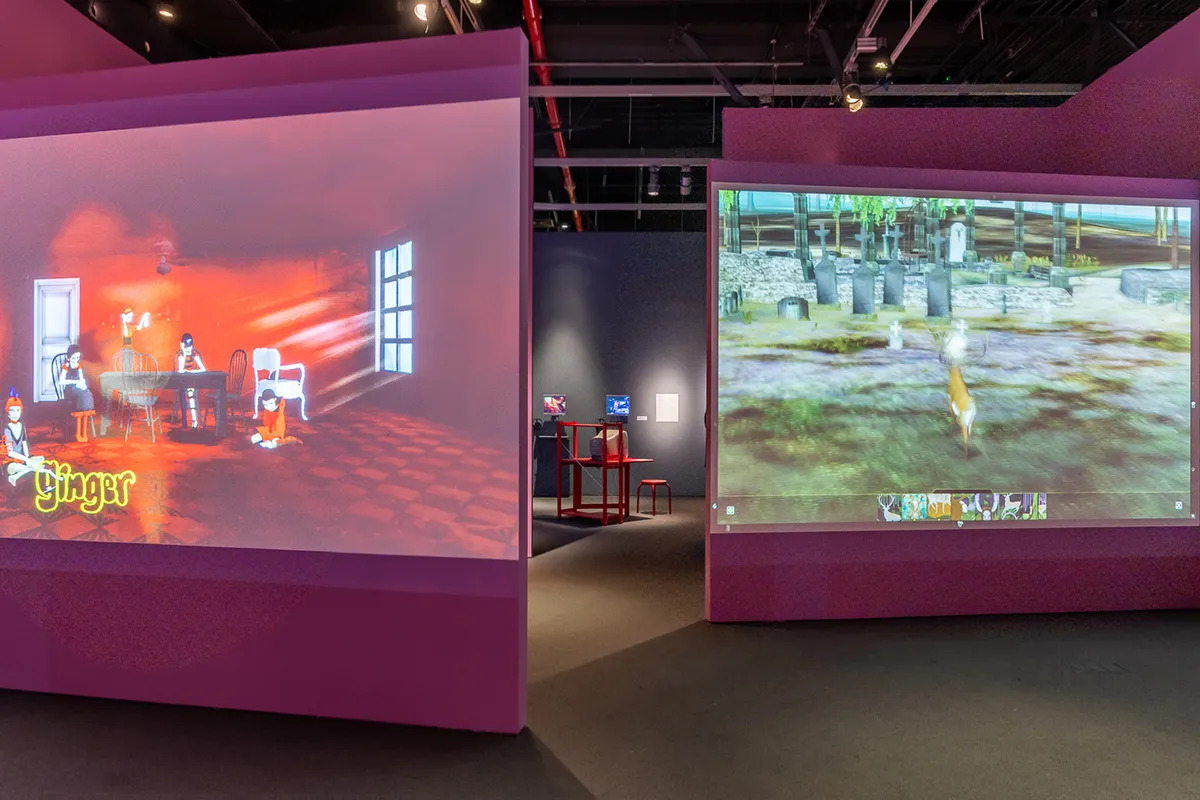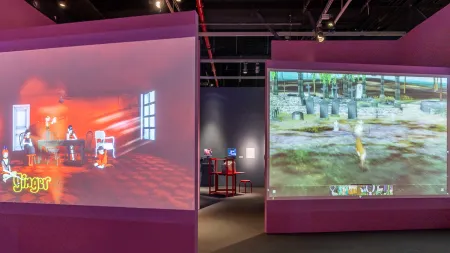
As digital art has consistently made headlines over the last few years—from the onslaught of NFTs to revisiting pioneers in the field to showcasing tech artists—it has taken the art world by storm. Given this recent upswing in interest, there’s still much to discover, particularly the artists who have been quietly pushing the bounds and formats of the medium for decades. Auriea Harvey is one such exemplar. If you’ve never heard of her, you’re probably not alone.
Harvey began her foray into digital art as the internet was developing in the early ’90s, right before it boomed. Though she studied sculpture at the Parsons School of Design in New York, she was drawn to all things digital, a self-described “obsession” that drove Harvey to experiment with a number of digital formats that span photography, sculpture, drawing, and video. Yet, her works are hardly static.
In the digital world, Harvey is known for artistic experimentations on the website entropy8.com as well as the independent game studio Tale of Tales, which produced such video games as The Endless Forest. With both endeavors, she was driven by the ability to craft narratives and have personal interaction in the digital realm—a through-line that continues in her practice even today. In fact, Harvey met her collaborator and partner Michaël Samyn online.
With digital art, “there’s nothing to fear here,” Harvey said from her studio in Rome, where she’s been living with Samyn since the start of the pandemic. The lockdown, she said, “had a lot to do with where I am today.”
Her breakthrough in the mainstream art world came only in 2021, with a solo show at bitforms gallery in New York, but lockdown restrictions prevented her from attending. For the exhibition, Harvey created physical sculptures, like Fauna (2018) and Minoriea (2021), busts which bare a resemblance to both the mythical creatures they each represent and the artist herself; she also created these objects as virtual versions that were available online and in augmented reality (AR) so that anyone around the world could experience her work. She additionally gave virtual tours of the show to people in-person and online. “I felt like it was something I had been training for my entire life,” she said.

While the hype surrounding NFTs has been declining, the history of digital art has become fertile terrain for the art world, wherein pathbreaking artists like Harvey are finding the spotlight. Harvey’s first institutional survey is now on view at the Museum of the Moving Image in New York through July 7. Titled “My Veins are the Wires, Your Body is the Keyboard,” the exhibition showcases more than 40 works from the past nearly four decades, including her net-based interactives, video games, and AR sculptures.
Harvey’s earliest experiments with digital processes began with photography, as she moved between darkroom manipulations and hand embellishments. JV, a 1995 print from a suite of three related works, shows sections of a floating head mashed together among an imagined psychedelic landscape, overlaid with doodle-like digital marks. Mike Szabo, from that same series, is split into three sections showing part of the titular singer-songwriter’s head, in one panel, as he looks at a vast landscape with an astronaut floating in space, in a second panel; below Szabo’s head is a repeated digital houndstooth pattern of a face, parts of which have been filled in. While they may seem stylistically different from one another as well as current works, these photographs demonstrate Harvey’s early processes and fascination with the digital. But Harvey soon followed later that same year with entropy8.com, which has been reconstructed for the exhibition.
Many of Harvey’s key works dating to the ’90s are relatively inaccessible today, as advancements in technology have spurred their obsolescence. Digital art nonprofit Rhizome helped bring a number of them back to life through an “emulation system that is showing these old works in the exhibition in their original context” as well as with their original hardware and wiring, according to Dragan Espenschied, Rhizome’s preservation director.
In organizing the show, Regina Harsanyi, MoMI’s associate curator of media arts, said she wanted to present the breadth of Harvey’s oeuvre in a way that is “brazenly interactive and primarily shown on historical hardware.” She added, “The process of creating these local emulations, where[in] the work was initially made to be in a Netscape 4 browser on a Windows 98 operating system, [and] having to emulate that environment on a CRT monitor from 1999 takes a certain kind of knowledge, skill set, and labor.”
More broadly, Espenschied said Harvey’s “uncompromising artistic vision—expressed on media and technology that at the time was probably not ready [for it]—is really striking.”
Coming from a background in conservation herself, Harsanyi said, “It was really important for me to show all the video games and majority of the web-based art in an interactive way and the way that it was meant to be experienced.”
She continued, “I did that not only to educate younger generations on the sculptural and aesthetic specificities of, say, ’90s web, but also in doing that I feel it stays true to the integrity of the artworks.” Games like The Endless Forest, for example, can be played both online and in the museum gallery.

Though Harvey’s interest in digital experimentation has been and continues to be an important aspect of her practice, she was never interested it in for the sake of simply using digital tools. From the beginning, Harvey was instead using these digital tools to explore more complicated topics like intimacy. “I wasn’t creating work that was about technology or about the internet or about computers, but about the humans using the computers, myself using computers, my body in front of the computer,” she said.
This line of inquiry continued as she made video games to explore personal narratives, not unlike a book, wherein users “are thrown into this body virtually and have to feel their way through this story” that is also “tightly melding [them] with a virtual character.”
Her drawings and sketchbook, also on display in a vitrine, offer another level of intimacy by showing not only the process but the artist’s hand. One is filled with seemingly random text and numerical doodles, while another shows more architectural or sculptural studies.
Harvey’s sculptures take this a step further, following a similar ideology that starts with bodily forms, often her own, and continually transforms them. Her ongoing piece Echo (2018—), a holographic monitor based on a scan of herself, explores her slow transformation into a cave-like copy, with the story of Echo, the mountain nymph from ancient Greek mythology who is doomed to repeat others, serving as a backdrop. While Echo exists as a digital work, Harvey also 3D prints these renderings in various materials and iterations—a back and forth process between the artist and the computer. “It’s a constant circularity between putting myself in and taking something out, like finding this organic way inside and outside of the screen,” Harvey said. In this transmutation between formats and forms, new characters are also born.
At the heart of each iteration, digital or otherwise, is the question of humanity. Despite decades of contemporary society’s own back and forth between self and technology, the digital, no matter how fundamental to our lives today, still remains elusive to many at best. In taking up digital media as a medium in its own right, Harvey said she hopes to “show people that this is not so strange, that this is all perfectly compatible.”
Grand Palais and Museum of the Moving Image Get New Leaders, and More: Morning Links for August 25, 2023
Ryan Kuo Discusses Race as Technology with Media Scholar Wendy Chun

We Stayed at France’s Newest ‘Super-Chalet’—Here’s What It Was Like

Margot Robbie, Carey Mulligan, Emily Blunt Turn Up for Chanel and Charles Finch Pre-BAFTA Party

Scientists are now making beef rice infused with real cow cells

NHL Turns Eyes to MetLife Stadium for Outdoor Games


